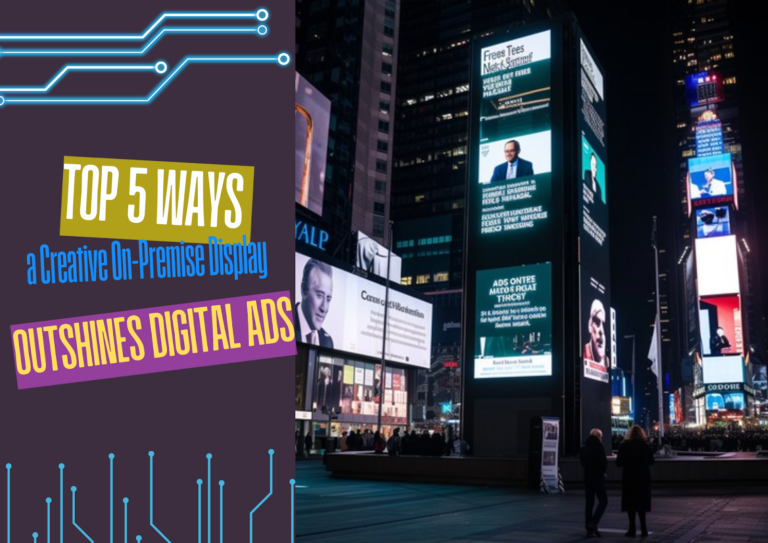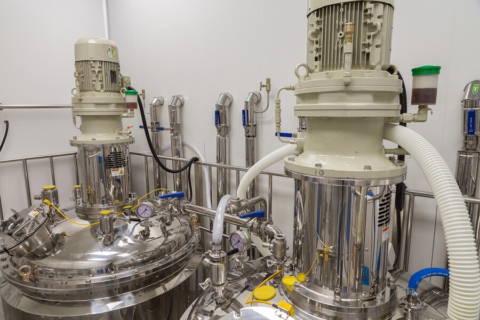In a world dominated by digital marketing, it’s easy to overlook the power of a well-executed on-premise display. But here’s the secret: while digital ads flood screens, creative physical displays demand attention, engage multiple senses, and leave a lasting impact.
Think about the immediate connection a striking storefront or eye-catching sign can make. It’s more than just advertising; it’s a personal interaction with your audience. Curious to know why on-premise displays might be your brand’s hidden superpower? Keep reading to discover how they outshine digital ads and drive real-world engagement!
The Power of Physical Presence in Modern Marketing
A creative on-premise display can transform your storefront into a powerful marketing tool. Research shows that physical displays create an immediate impact, with shoppers entering stores based on compelling signage alone. Businesses can create memorable experiences that resonate with customers through strategic in-store marketing strategies. You can find the right creative on-premise display at various point-of-sale solution providers
1. Immediate and Tangible Impact
Physical marketing creates an instant connection with customers using sensory touchpoints that digital screens can’t replicate. When customers encounter a well-designed physical display, they experience a three-dimensional presentation that naturally draws their attention and encourages exploration. This multisensory engagement creates a more memorable experience than just scrolling past digital ads.
The power of tangible displays lies in their ability to create immersive experiences. Studies indicate that consumers are 400% more likely to engage with creative physical displays compared to static digital content, demonstrating the superior impact of retail display advertising. This heightened engagement stems from the display’s ability to break through the digital noise and create genuine moments of connection with potential customers.
Physical displays may also evolve to adapt to their setting in a manner that is not available for digital advertising. They can take on multiple elements of texture, lighting, and depth that all collaborate harmoniously to reinforce a singular brand message. These adaptations help companies create displays that seamlessly blend into their surroundings while maintaining brand integrity.
2. Precision in Local Targeting
Implementing effective local targeting advertising strategies through on-premise displays offers unprecedented control over how and when customers encounter your message. Unlike digital ads that may reach users regardless of their location or shopping intent, physical displays connect with customers who are already in your vicinity and are more likely to make immediate purchasing decisions.
This geographical precision is crucial for companies aiming to build strong community ties—cultural nuances, which resonate strongly with the target audience. Because messaging and design elements can be adapted in response to real-time local factors, on-premise displays are highly effective at inducing foot traffic and thereby, increasing visits to the store.
3. Enhanced Brand Recall and Memory
When it comes to brand recall strategies, physical displays excel by creating lasting impressions through unique design elements that engage multiple senses simultaneously. This multisensory approach helps forge stronger neural connections, making the brand message more memorable and impactful over time.
Physical signs are also more descriptive of a brand’s message. Selected aspects like material, color palette, and style of presentation alone can help businesses paint more vibrant pictures of their values and personality than a digital expression would do alone. This potential for storytelling connects the business with customers on an emotional level, resulting in greater loyalty and brand recognition.
4. Cost-Effectiveness and Longevity
Cost-effective advertising solutions through on-premise displays provide substantial long-term value that digital advertising often struggles to match. Digital campaigns need constant investment, while physical displays offer long-term exposure with minimal costs after installation.
| Aspect | On-Premise Display | Digital Advertising |
| Initial Investment | One-time cost | Ongoing expenses |
| Maintenance | Minimal | Regular updates required |
| Longevity | Years of exposure | Limited campaign duration |
| ROI Potential | High long-term value | Variable returns |
| Environmental Impact | One-time production | Continuous energy consumption |
| Audience Engagement | Consistent exposure | Dependent on algorithm changes |
This cost-effectiveness becomes even more apparent when considering the cumulative impact over time. While digital advertising costs continue to rise with increasing competition for online attention, the value of a well-maintained physical display appreciates as it becomes an established part of the local landscape.
5. Authentic Brand Connection
In the comparison of physical advertising vs digital advertising, physical displays demonstrate clear advantages in creating genuine connections with customers. These displays become part of the community fabric, contributing to the local aesthetic and culture in ways that digital ads cannot replicate.
This is key in today’s market, where consumers seek authentic brand experiences. Adding a sense of belonging and connection that resonates with customers.
This integration helps businesses to show their commitment to a community while remaining uniform in a brand. Businesses, for example, can include local cultural sentiments and current affairs in their displays and thus associate the firm with significant relationships that turn passers-by permanently into customers.
Maximizing Your Display’s Impact
To optimize your on-premise marketing efforts, businesses need to consider several key factors that contribute to display effectiveness. First, focus on creating eye-catching designs that align with your brand identity while standing out in your local environment. This requires careful consideration of color schemes, lighting, and materials to create a cohesive visual experience.
Second, maintain consistency in your brand messaging across all marketing channels, ensuring that your physical displays complement your digital presence rather than competing with it. This integrated approach helps reinforce your brand message and increases overall marketing effectiveness.
Third, regularly update your displays to reflect seasonal changes, special promotions, and evolving customer needs. This dynamic approach keeps your marketing fresh and engaging while demonstrating your brand’s adaptability and relevance.
Finally, incorporate interactive elements that encourage customer engagement and create memorable experiences. These interactions can range from simple touch elements to complex digital integrations, depending on your budget and objectives.
Conclusion
The enduring effectiveness of physical displays in driving customer engagement and sales cannot be overstated. By implementing these creative signage ideas and strategies, businesses can create meaningful connections with their target audience while maintaining cost-effective marketing solutions. The key to success lies in understanding how to leverage the unique advantages of physical displays while integrating them into a comprehensive marketing strategy.
Ready to transform your business presence? Start by evaluating your current display strategy and implementing these proven techniques to enhance your brand’s visibility and impact.
Frequently Asked Questions
1. Which businesses benefit most from on-premise displays?
Retail stores, restaurants, and service-based businesses see the highest impact, with increased foot traffic through effective storefront display design. These businesses benefit from the immediate visibility and local targeting that physical displays provide.
2. How do on-premise displays compare to digital ads in terms of cost?
On-premise displays typically offer better long-term value, with a one-time investment generating continuous exposure compared to recurring digital ad costs. The initial investment often pays for itself through sustained visibility and ongoing customer engagement without the need for constant financial input.
3. What makes an on-premise display effective?
Successful displays combine compelling visuals, clear messaging, and strategic placement to maximize foot traffic marketing potential. The most effective displays consider factors such as visibility angles, lighting conditions, and pedestrian flow patterns to optimize their impact on potential customers.

Daniel J. Morgan is the founder of Invidiata Magazine, a premier publication showcasing luxury living, arts, and culture. With a passion for excellence, Daniel has established the magazine as a beacon of sophistication and refinement, captivating discerning audiences worldwide.





